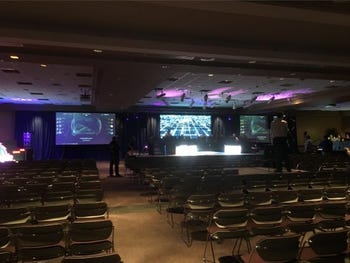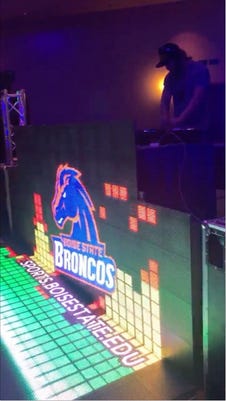Trending
Opinion: How will Project 2025 impact game developers?
The Heritage Foundation's manifesto for the possible next administration could do great harm to many, including large portions of the game development community.
It’s only a matter of time before even more colleges and high schools bring gaming into the fold of interscholastic athletics. What this means for developers and the gaming industry is unclear, what is clear is that the future of gaming is bright.

Beyond my identity as a gamer lies my identity as a musician, DJ, and performing artist. Very rarely do these worlds overlap, but when they have it’s been a treat, to say the least. Most recently, I was hired to DJ Boise State University’s eSports Launch Party, an event set to usher in BSU’s newly minted eSports program.
 I wasn’t sure what to expect, at first. When I showed up for soundcheck, the Jordan Ballroom was empty, save the announcers, a couple of other people doing sound and lights, and the BSU eSports team. The venue was set up with hundreds of chairs, but I had a hard time believing a collegiate eSports exhibition primarily focusing on League of Legends would actually fill them. Nevertheless, the setup was impressive: ten computers on-stage in front of three large displays to broadcast the action left, right, and center; TVs with connected consoles in the back of the room to facilitate games of Overwatch and Rocket League; assorted junk food; and a slick, DJ booth with LED dispaly for me to spin from. Needless to say, I was already impressed by the facilities — and then people started showing up.
I wasn’t sure what to expect, at first. When I showed up for soundcheck, the Jordan Ballroom was empty, save the announcers, a couple of other people doing sound and lights, and the BSU eSports team. The venue was set up with hundreds of chairs, but I had a hard time believing a collegiate eSports exhibition primarily focusing on League of Legends would actually fill them. Nevertheless, the setup was impressive: ten computers on-stage in front of three large displays to broadcast the action left, right, and center; TVs with connected consoles in the back of the room to facilitate games of Overwatch and Rocket League; assorted junk food; and a slick, DJ booth with LED dispaly for me to spin from. Needless to say, I was already impressed by the facilities — and then people started showing up.
I was blown away by how many people actually attended this event. Every seat was filled. The energy was palpable. It was the difference between watching the LCS on Twitch and actually going to a live sporting event. I never actually thought that I’d experience that in Boise, Idaho ... I mean, I know the numbers support the theory that I would, at least eventually — yet, it was surreal nonetheless to watch BSU not only roll out its eSports program, but to see it received with such enthusiasm and gusto.
 For those unaware, eSports represents one of the fastest growing facets of sports-entertainment. ESPN reports that around 205 million people watched or played eSports in 2014 — which is equivalent to the population of the fifth largest country in the world — and that figure has only grown since. Business Insider’s more recent numbers estimate that “approximately 300 million people worldwide tune in to eSports today, and that number is growing rapidly. By 2020, that number will be closer to 500 million.”
For those unaware, eSports represents one of the fastest growing facets of sports-entertainment. ESPN reports that around 205 million people watched or played eSports in 2014 — which is equivalent to the population of the fifth largest country in the world — and that figure has only grown since. Business Insider’s more recent numbers estimate that “approximately 300 million people worldwide tune in to eSports today, and that number is growing rapidly. By 2020, that number will be closer to 500 million.”
The real numbers, however, exist in eSports’ bottom line. Global eSports marketing agency Newzoo suggests that the eSports economy will grow to $696 million by the end of 2017, which equates to a year-on-year growth of 41.3 percent. They project that brand investments over time will double by 2020, pushing the industry’s worth to a whopping $1.5 billion. Important to note is that this doesn’t include betting on eSports. According to Newzoo:
“...sports betting is a far bigger business than sports media rights, sponsorship, and consumer revenues put together. As an example, the NFL generated $13 billion last year, but betting and fantasy leagues around the NFL games are supposed to have made north of $50 billion. With most big betting companies already embracing esports betting on a global scale, it’s possible that esports betting alone is larger than the esports economy itself.”
As a casual gamer, I was stoked to see a move toward the acceptance of competitive gaming in schools, even if I’d never participated competitively in my life. Ohio University’s website lists a number of benefits of participating in interscholastic athletic programs, including increased academic success and future success, as well as better quality of life, and I feel like I was lucky enough to find as much in both physical and mental athletic programs. I was a physical athlete in junior high and high school for a time, but I was also involved with high school speech and debate. What I resented was how different these worlds were — I didn’t feel like I fit in with adrenaline-fueled physical sports, so I turned to one of the only interscholastic programs that I was aware of which revolved around intellect.
At the time this article was written, the National Association of Collegiate eSports consisted of 30 member colleges and counting, and collegiate scholarships are being set aside for gaming that cover anywhere between 35 and 75 percent of tuition. As one would expect, this means that high school eSports is growing too. I only wish that eSports had been as big then, 10 years ago, as they are now. Still, I’m glad that as competitive gaming is taken more seriously, students who identify more as “mentally” than “physically” athletic will find a wider variety of offerings in interscholastic eSports programs, as well as the acceptance, community, and success traditionally reserved for physical sports.
 After the event was over, I couldn’t help but wonder what the future of eSports and gaming is going to be like. I’ve already written a three-part series on the future of eSports, and in the third part I contend that the further popularization of virtual reality (VR) will be instrumental in bringing about that future. After all, Homeland Security and other government agencies are already using VR for disaster response training, while the private sector has been honing its application in areas related to architecture and real estate — why wouldn’t we expect VR to revolutionize gaming if it’s already revolutionizing industries completely unrelated to tech?
After the event was over, I couldn’t help but wonder what the future of eSports and gaming is going to be like. I’ve already written a three-part series on the future of eSports, and in the third part I contend that the further popularization of virtual reality (VR) will be instrumental in bringing about that future. After all, Homeland Security and other government agencies are already using VR for disaster response training, while the private sector has been honing its application in areas related to architecture and real estate — why wouldn’t we expect VR to revolutionize gaming if it’s already revolutionizing industries completely unrelated to tech?
Interestingly, when I wrote the “Future of eSports” posts in June and July of 2017, I’d spent plenty of time reading about VR, but hadn’t spent more than probably 15 minutes in cool (but ultimately lacking) demos. Since then, I’ve spent a couple hours exploring VR-tech at a local facility that tours potential property buyers through virtual buildings during the day, and caters to gamers and family groups as a VR gaming arcade at night. I have to give a big shout-out to Brendan Smythe over at the VR-1 Arcade for providing experiences which have lead me to believe that VR will someday sidle up right next to, if not fully supplant, the current eSports monolith that is League of Legends. It may take time, but it’ll happen.
Nevertheless, it’s important to consider that we have no idea how the rise of eSports, with or without VR-tech, will affect future generations. For example, we’re just now learning as a society that concussions associated with playing American Football, a sport that’s been around for decades, are much more rampant and deadly than we previously realized. It’s possible that there are risks inherent to gaming and technology-use that we are simply unaware of yet. While anecdotal, I’m reminded of a close friend in college who essentially dropped off the face of the earth because he simply would not stop playing video games. The rise of technology addiction centers and robust treatment programs in the U.S. and Asia support the notion that at least a portion of the population may suffer from “Internet gaming disorder,” and a newer book by Simon Parkin called Death by Video Game explores just how fatal this disorder can be. Of course, most likely won’t collapse dead because they’ve been sitting around, addicted to playing too many video games — yet the risk of serious health issues rises in people who are inactive, so much so that some people will claim that “sitting is the new smoking”. As gaming tech like VR becomes more potent, I have to wonder what types of repercussions will arise from further immersion in virtual worlds, especially in regards to young people. By no means am I suggesting that the potential harms of the rise of eSports will anywhere near compare to its benefits — just that it’s better to keep an eye out for those harms, rather than become aware of them via their negative effects in the future.
To round this out, BSU’s inaugural eSports launch made me realize just how quickly competitive gaming is being accepted as a serious sport. It’s only a matter of time before even more colleges and high schools bring gaming into the fold of interscholastic athletics. What this means for developers and the gaming industry as a whole is unclear. What is clear is that the future of gaming is bright, and I’m excited to be a part of it, be that as a writer, DJ, spectator — or, if I’m lucky to experience something like this again, all three at the same time.
You May Also Like